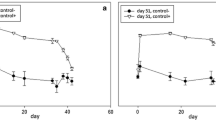Abstract
Denitrification and N2O emission rates were measured following two applications of artificial urine (40 g urine-N m−2) to a perennial rye-grass sward on sandy soil. To distinguish between N2O emission from denitrification or nitrification, urine was also applied with a nitrification inhibitor (dicyandiamide, DCD). During a 14 day period following each application, the soil was frequently sampled, and incubated with and without acetylene to measure denitrification and N2O emission rates, respectively.
Urine application significantly increased denitrification and N2O emission rates up to 14 days after application, with rates amounting to 0.9 and 0.6 g N m−2 day−1 (9 and 6 kg N ha−1 day−1), respectively. When DCD was added to the urine, N2O emission rates were significantly lower from 3 to 7 days after urine application onwards. Denitrification was the main source of N2O immediately following each urine application. 14 days after the first application, when soil water contents dropped to 15% (v/v) N2O mainly derived from nitrification.
Total denitrification losses during the 14 day periods were 7 g N m−2, or 18% of the urine-N applied. Total N2O emission losses were 6.5 and 3 g N m−2, or 16% and 8% of the urine-N applied for the two periods. The minimum estimations of denitrification and N2O emission losses from urine-affected soil were 45 to 55 kg N ha−1 year−1, and 20 to 50 kg N ha−1 year−1, respectively.
Similar content being viewed by others
References
Aulakh M S, Rennie D A and Paul E A 1984 Acetylene and N-serve effects upon N2O emissions from NH4 and NO3 treated soils under aerobic and anaerobic conditions. Soil Biol. Biochem. 16, 351–356.
Ball R, Keeney D R, Theobald P W and Nes P 1979 Nitrogen balance in urine-affected areas of a New zealand pasture. Agron. J. 71, 309–314.
Carran R A, Ball P R, Theobald P W and Collins M E G 1982 Soil nitrogen balances in urine-affected areas under two moisture regimes in Southland. N. Z. J. Exp, Agric. 10, 377–381.
De Klein C A M and Van Logtestijn R S P 1994 Denitrification in the top soil of managed grasslands in The Netherlands in relation to soil type and fertilizer level. Plant and Soil (3179, accepted).
Doak B W 1952 Some chemical changes in the nitrogenous constituents of urine when voided on pasture. J. Agric. Sci. 42, 162–171.
Haynes R J and Williams P H 1992 Changes in soil solution composition and pH in urine-affected areas of pasture. J. Soil Sci. 43, 323–334.
Jarvis S C 1991 Nutrient cycling and flows.In IGER report 1991.
Klemedtsson L, Svensson B H and Rosswall T 1988 Relationships between soil moisture content and nitrous oxide production during nitrification and denitrification. Biol. Fertil. Soils 6, 106–111.
Monaghan R M and Barraclough D 1992 Some chemical and physical factors affecting the rate and dynamics of nitrification in urine-affected soil. Plant and Soil 143, 11–18.
Monaghan R M and Barraclough D 1993 Nitrous oxide and dinitrogen emissions from urine-affected soil under controlled conditions. Plant and Soil 151, 127–138.
Moreal C, McGill W B and Nyborg M 1986 Spatial heterogeneity of substrates: effects on hydrolysis, immobilization and nitrification of urea-N. Can. J. Soil Sci. 66, 499–511.
Parton W J, Mosier A R and Schimel D S 1988 Rates and pathways of nitrous oxide production in a shortgrass steppe. Biogeochemistry 6, 45–58.
Ryden J C 1986 Gaseous losses of nitrogen from grassland.In Nitrogen Fluxes in Intensive Grassland Systems. Eds. H G van der Meer, J C Ryden and G C Ennik. pp. 59–73. Martinus Nijhoff Publishers, Dordrecht, The Netherlands.
Ryden J C, Skinner J H and Nixon D J 1987 Soil core incubation system for the field measurement of denitrification using acetylene-inhibition. Soil Biol. Biochem. 19, 753–757.
SAS Institute Inc. 1985 SAS/STAT Guide for personal computers, Version 6 Edition. Gary, N.C. SAS Institute Inc.
Sherlock R R and Goh K M 1983 Initial emission of nitrous oxide from sheep urine applied to pasture soil. Soil Biol. Biochem. 15, 615–617.
Skiba U, Smith K A and Fowler D 1993 Nitrification and denitrification as sources of nitric oxide and nitrous oxide in a sandy loam soil. Soil Biol. Biochem. 25, 1527–1536.
Tiedje J M 1982 Denitrification. Chap. 47.In Methods of soil analysis, Part 2. Chemical and Microbiological Properties. pp. 1011–1026. ASA-SSSA, Madison, USA.
Van derMeer H G 1991 Stikstofbenutting en-verliezen van gras-en maisland. CABO, Wageningen, The Netherlands (In Dutch).
Vertregt N and Rutgers B 1988 Ammonia volatilization from grazed pastures. CABO-Report No. 84. Centre for Agrobiological Research, Wageningen, The Netherlands.
Author information
Authors and Affiliations
Rights and permissions
About this article
Cite this article
de Klein, C.A.M., van Logtestijn, R.S.P. Denitrification and N2O emission from urine-affected grassland soil. Plant Soil 163, 235–241 (1994). https://doi.org/10.1007/BF00007973
Accepted:
Issue Date:
DOI: https://doi.org/10.1007/BF00007973




